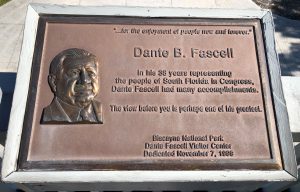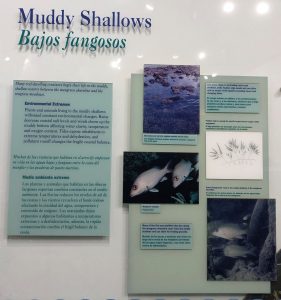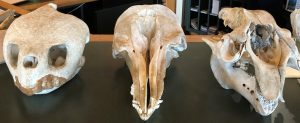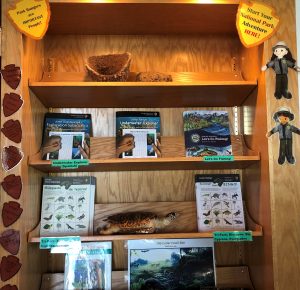
Sea breezes, bay views draw many to park
HOMESTEAD, Fla. – The calm sea breeze blew strongly enough to shake the trees that surrounded the serene atmosphere of Biscayne National Park’s Dante Fascell Visitor Center.
On a low-tide part of the day from the visitor center, by facing the right position looking across the beautiful Biscayne Bay, it was a thrill to be greeted with the sight of two landmarks. The first landmark representing the south end of Key Biscayne and the second being the Miami skyline. It was the perfect place to sit down and read a book or have a picnic with some of your closest friends and families.
 |
A plaque honoring the late Congressman Dante B. Fascell in the establishment of Biscayne National Park on June 28, 1980 (Photos by Shanika Isaacs). |
Biscayne National Park, located beyond a stretched perimeter of South Florida’s Biscayne Bay, was famous for being 95% under water. It is a subtropical place that protects its eco-system and this attracts different ocean species to the park. Tourists and visitors alike travel near and far to enjoy the sights of the mainland mangrove shorelines, warm shallow bays and small islands and keys. In the park’s theater, much can be learnt from an introduction video of the site and how it was discovered. By participating in the different educational experiences at the visitor’s center, it can make the duration of the visit more meaningful.
“I enjoy working at Biscayne National Park because of the different tourists and visitors who walk through that door. The tranquility of the people and their pursuit for knowledge always surprises me. I enjoy when we are all able to learn something new, which builds on both of our experiences,” Esmeralda Reyes, a park volunteer, said.
Every Saturday for two years, Reyes found herself dedicating time to Biscayne National Park. In her experience she expressed that many tourists visited the park during the winter or cooler seasons, as opposed the summers and dry seasons.
“We get tourists from all over the world. Many internationals come in the winter after the hurricane season. That’s one of the reasons why we offer our brochures in many different languages to make sure that we are communicating to our customers what they need to know,” she said.
Reyes said that one of the most popular park activities was its Boca Chita Key boat tour, which she confessed was also her all-time favorite.
“A lot of people enjoy this tour more because it gives them the opportunity to do it with their families and friends. So many of them come with their families and in large groups, so being able to go through this experience together it excites them,” she added.
| A display about the bay’s muddy shallows at Biscayne National Park Center Gallery. |  |
She stated that Biscayne National Park offered to each visitor an opportunity to experience history which includes the natives, the park’s construction and the people. Reyes emphasized that it was a place for many to make a connection with and bask in the glories of what the park had to offer to them.
John Owens, another park volunteer, happily dedicated 25 years of seasonal service to Biscayne National Park. In his experience as a tour guide, he shared similar details that solidified what people looked for and encountered when visiting the park.
“Some of the activities we offer are fishing, boating, camping, canoeing and kayaking. We also offer snorkeling to see the coral reefs and the shipwreck we have on the Maritime Heritage Trail. Many of our tours are accompanied by adults, who all get the chance to explore Elliott or Adams Keys depending on which one they paid for,” Owens said.
He continued by sharing some of the essential things people needed when going on one of these tours that would make or break the experience.
“You need bug spray and lots of it,” he said sternly, “And not just any old bug spray. You need the ones with DEET in it to repel the mosquitoes away.”
Owen explained that during the summers due to the warmth of the climate, it was the perfect setting for increased bugs and insects. As a result, it was always expected to have a significantly smaller number of visitors traveling to the park during this time.
“And when it’s not the bugs it’s the summer heat. The temperatures in Miami is unbearable during the summers, so not many people come down here during this time. For us to wear repellent on these tours it is considered bad for the plants, but we try our best to find that balance of protecting the park, ourselves and our visitors,” he said.
At the National Parks Conservation Association, its main goal is to protect and preserve the nation’s most iconic and inspirational places for present and future generations. It is seen as the voice of America’s national parks, a group that lobbies on their behalf. Assistant Director of National Partnership, Jacqueline Crucet, who worked for the organization for the past 11 years, was solely responsible for connecting people to their national parks and its public policies.
| The skeleton remains of a manatee, dolphin and turtle are some of the animals protected at the park. |  |
“We help the park service to ensure they have the proper funding from the government for certain projects. We are basically Biscayne National Park’s watchdog group, that preserves the secrecy of the park grounds,” Crucet said.
She shared having to work closing with the park to preserve its wetlands, ecosystem, animals and plant life. If a dispute arose about the park disregarding the rules and guidelines they were required to follow for the protection of the park, the organization was would be active in suing the park to assure the rules were followed.
“We had a dispute with Biscayne National Park about their Marine Zone that was not being implemented. We also have discussions about the limitations of the park’s trolley, which is the only service offered to visitors to travel to the park. These are some of the matters we address, but they are currently being dealt with on both sides,” she said.
She shared how working with the different voluntary groups both at the park and around the country, helped with changing the park atmosphere. She explained how much safer the park became, alongside the amount of money they saved on outsourcing services.
In the military, passionate humanitarians dedicate much of their time to a voluntary program to help out the community surrounding their home base. One such volunteer was Torrey Ben Sanchez, an active military personnel for the Homestead Base. He shared his weekly routine of sacrificing a couple hours out of his Saturdays, to help Biscayne National Park in fishing out large piles of trash from Biscayne Bay.
“I’ve been to 16 countries and the level of trash in this park’s sea is very sad to see. We are usually out in the bay for 2½-3 hours one Saturday of the month, which ends with us collecting around 200 to 400 pieces of trash that day. So, within the past six months of being here we have collected 1,200 pounds of trash and debris out in the bay,” Sanchez said.
 |
An activity corner for both adults and kids to learn about the park and its eco-system. |
He explained how eye opening it was for him and his team to ride around in his boat and see all the trash that floated in the ocean. In helping the park protect itself from human influence, it has also help visitors in having a fulfilling experience when touring the Biscayne Bay.
“It is my service to Homestead and I enjoy doing it,” he said.
Elizabeth Strom, a park ranger, at Biscayne National Park said volunteers such as Torrey Sanchez himself were vital to the park. For the fiscal year of 2019 approximately 407 volunteers cleaned up a total of $35, 238 pounds of garbage by donating 2,329 hours, she explained.
“It is always wonderful to have people like Mr. Sanchez to help the park with these types of matters. By assigning a dollar value to each volunteer’s time, we reported that they donated $59,226.47 to help clean up the park’s waters. Without these volunteers the park would have had to pay for these services out of pocket, which would probably cost a lot more than the previously estimated cost,” Strom said.
Strom confessed how wonderful it was to have each volunteer connect with the park. She explained how getting out on a boat added to one’s experience of “owning the park” and playing a part in protecting it. Many different types of groups, including college kids, all took part in embracing such activities.
“At the end of the day, we all want to make sure that our visitors all have something to take back with them, wherever they came from, having had a connection with the park, to recognize some architect, or reminisce on the sound of the birds chirping, which reminds them of back home. We do whatever we can to keep the park inviting for visitors and to preserve its finery for future purposes,” she said.
If You Go
- Biscayne National Park, Dante Fascell Visitor Center
- 9700 SW 328th St., Homestead, Fla. 33033.
- Web site: https://www.nps.gov/bisc/planyourvisit/hours.htm.
- Telephone: 305-230-1144.
- Open daily from 9 a.m. to 5 p.m.

Comments are Closed